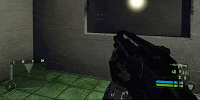The BRAWL² Tournament Challenge has been announced!
It starts May 12, and ends Oct 17. Let's see what you got!
https://polycount.com/discussion/237047/the-brawl²-tournament
It starts May 12, and ends Oct 17. Let's see what you got!
https://polycount.com/discussion/237047/the-brawl²-tournament
Breakable environments discussion (56k warning)
So I figured it'd be good to discuss breakable environments. First here are some examples, some are procedural breakable objects, some are purely replacing unbroken objects with cut up meshes, and some are a mixture, it seems.
Gears of War 2 tech demo/Unreal Engine 3 improvements
(procedural mixed with various art assets?)

Stranglehold (UE3 game)
(from some tests, it appears the unbroken objects get replaced with pre-cut objects on the fly, like many other games, there's just a whole lot more in this game!)

Messing around in CryEngine 2 (Sandbox 2)
(the glass is 2D/procedural, and cannot be too curved)

(Mixture of procedural, and a premade "broken" piece being added to the new end of the tree)

Here's the SDK documentation on breakable objects in CE2, BTW,
http://doc.crymod.com/AssetCreation/frames.html?frmname=topic&frmfile=index.html
So how do you think this will effect your workflow, the more games use this?
What should the artists be aware of when working with such a workflow?
Gears of War 2 tech demo/Unreal Engine 3 improvements
(procedural mixed with various art assets?)

Stranglehold (UE3 game)
(from some tests, it appears the unbroken objects get replaced with pre-cut objects on the fly, like many other games, there's just a whole lot more in this game!)

Messing around in CryEngine 2 (Sandbox 2)
(the glass is 2D/procedural, and cannot be too curved)

(Mixture of procedural, and a premade "broken" piece being added to the new end of the tree)

Here's the SDK documentation on breakable objects in CE2, BTW,
http://doc.crymod.com/AssetCreation/frames.html?frmname=topic&frmfile=index.html
So how do you think this will effect your workflow, the more games use this?
What should the artists be aware of when working with such a workflow?
Replies
Not much for artists to do here, it's really going to be driven by the tech itself, except to keep the lines of communication open with your programmer buddies at work. They're the ones who will be creating the actual cuts, with their 1337 coding skillz. Well, besides influencing the way things will be rendered, artists can add the ancilliary particle effects and such.
I searched, but only got a Gears of War 2 thread and another thread which didn't discuss it.
[ame]
But as Eric said, there just isn't much for artists to do. And for that you should rejoice.
most breakable objects in UE3 games are created by the artists, they usually make the model first, then break it down into individual pieces, and after a lengthy process of making it into a skeletal mesh, they bring it into PHat editor which then allows the mesh to be given physics properties. Then you can place it into the game to be destroyed.
I maybe missing a few steps on the process. I'm experimenting with this in UT3.
You can check some this out in the Bourne Conspiracy demo now on Xbox Live.
-Tyler
http://www.mirvadim.com/index.html
"RayFire Tool gives You ability to shoot, destroy, demolish, ruin, break down, make havoc, blow up, burst, detonate, explode and do other similar things..."
I think these guys are chatting about real time 3D breakable environemnts rather than ones which require a dedicated renderer. Though it would be cool to see these tools go into real time engines.
The 2 main third party engines Ive heard of are havok and Physx(used to be ageia now owned by nvidia)
http://www.havok.com/
http://www.nvidia.com/object/nvidia_physx.html
However, after a few minutes in the match, stuff will start getting broke, and the frames just go way down, often 8-12fps. Supposedly a PPU card helps, but not that much it seems. This is with a Q6600@3ghz.
Also, for UE3, yes, most of it *has* been artist-generated objects, but during Epic's tech demo, Mr. Sweeney discussed it as being purely procedural, unless I'm mistaken (besides modeling the metal that will be inside the concrete, etc.).